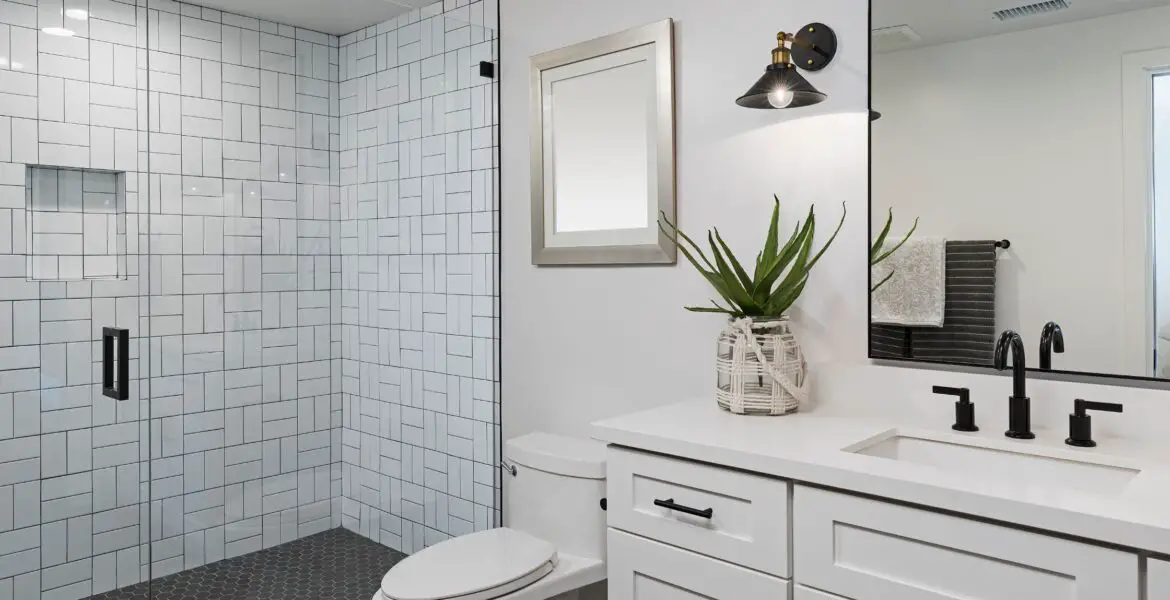Are you struggling to ventilate a bathroom without windows?
I can relate. My master bathroom has one small window, but it still lacks proper ventilation. As a result, my bathroom takes forever to dry!
If your bathroom is suffering from lingering odors, stained ceilings, and mold, your bathroom needs proper ventilation ASAP.
In this post, I’ve researched and listed 13 simple ways to ventilate a bathroom without windows.
For easy reference, these methods have been categorized based on price. I’ve also included the level of difficulty so you can see if each solution is easy or difficult to execute.
Keep reading to discover how to ventilate a bathroom without windows.

*Disclosure: This post may contain affiliate links that are at no additional cost to you, and I may earn a small commission if you purchase any products via my links. I only recommend products that I would use myself, and all opinions expressed here are my own. Read the full privacy policy here.
Table of Contents
5 Signs Your Bathroom Has Poor Ventilation
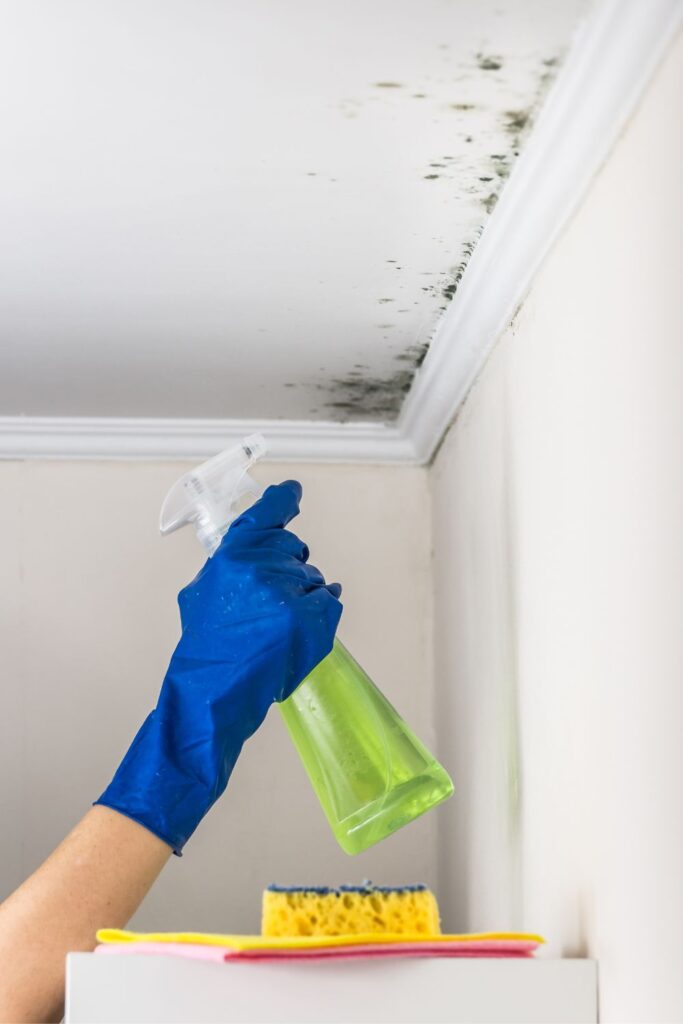
Stuffiness
Look out for a muggy and heavy environment or a persistent musty smell.
Excess moisture
Condensation happens frequently on walls and bathroom fixtures and mirrors will consistently fog up.
Lingering smells
Odors from the toilet or strong cleaning products stay for a long time.
Stained ceilings
Watch out for discoloration on ceilings. High humidity can also cause water damage, wood rot, and bubbled/peeled paint. Severe cases can cause drywall/plaster ceilings to sag or collapse.
Mold
This is very common in bathrooms lacking ventilation. You’ll usually find mold where moisture builds up in the bathroom such as grout, shower enclosure corners, etc. Mold is extremely dangerous and can cause all sorts of health issues.
Are one or more of these signs present in your bathroom? If you answered yes, your bathroom needs better ventilation.
Keep scrolling to learn how to properly ventilate your bathroom.
Related: Regular Cleaning vs Deep Cleaning Your Home
How To Ventilate A Bathroom Without Windows For Free
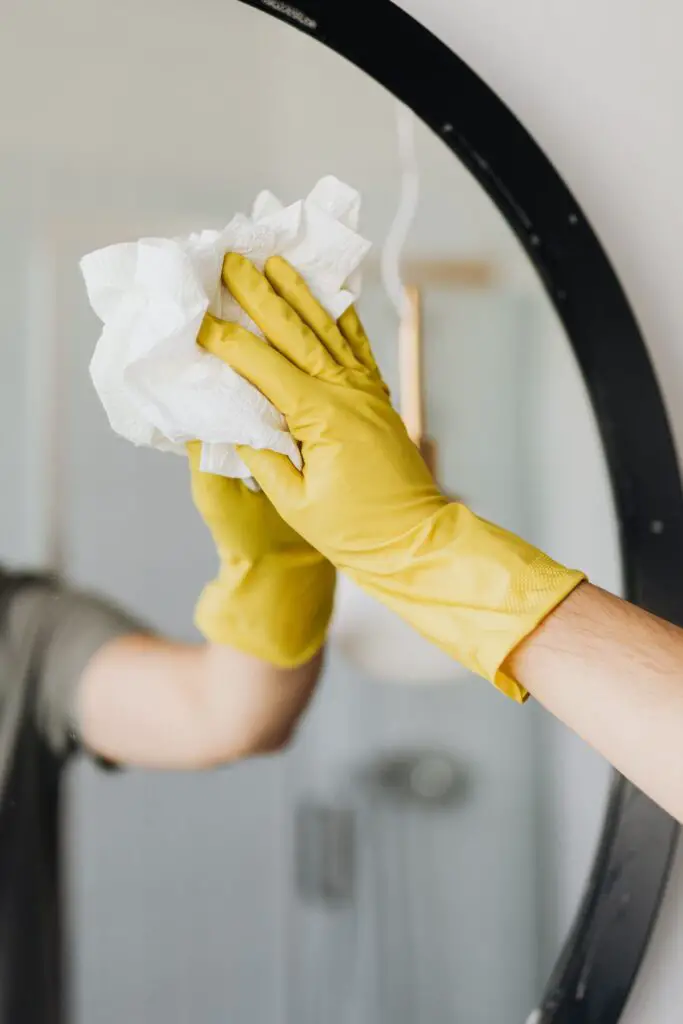
Here are 5 hassle-free ways to ventilate a bathroom without windows for free. These solutions are quick temporary fixes and are best used with other permanent methods to achieve the best results.
1. Wipe down wet surfaces
If your bathroom doesn’t have a window, chances are the wet surfaces in your bathroom like the countertops and floors will take a long time to dry.
Besides that, condensation happens in every bathroom. It is a process in which water vapor turns into liquid. In the bathroom, the air holds a lot of moisture when someone takes a shower or a bath. When humid air comes into contact with a cold surface, it creates small droplets of water on the surface.
It’s important to reduce condensation and humidity in the bathroom because it can lead to black mold, which can cause severe health issues.
You can ventilate your windowless bathroom by using a microfiber cloth to wipe down the wet surfaces of your bathroom like the countertop, sink, tub, toilet, and walls. Doing this helps to prevent condensation and removes humidity.
Besides that, you should use a squeegee to remove excess water from shower screens or partitions and mirrors.
The floor should be mopped too to keep the bathroom dry.
These steps will not only keep your bathroom somewhat moisture-free, but they will also keep your bathroom safe for the next person to use.
Difficulty Level: 😩😩 (Not challenging, but tedious!)
2. Keep the bathroom door open
An effective way of ventilating a windowless bathroom is to keep the bathroom door open at all times.
Keeping the bathroom door open allows hot air to escape and circulate. Humidity will increase if air is trapped inside a room with no windows.
Additionally, leaving the door ajar will let out any steam that has accumulated when you are taking a hot shower or bath.
Don’t forget to open your shower door as well; otherwise, you won’t see the difference.
If you have a shower curtain, don’t push it all the way back. Doing this will create folds in the curtain, which will trap tiny droplets within them. Just open it slightly to allow air to flow freely.
Difficulty Level: 😩 (Easy, but not always practical!)
3. Dry your towels outside the bathroom
Do you dry your used towel inside your bathroom? If you answered yes, it’s time to stop.
Drying your used towel inside a bathroom is a big no-no. Not only does it increase the level of moisture in the bathroom, but it also causes pools of water to form on the floor.
Furthermore, wet towels are hard to dry in a windowless bathroom. When towels are not fully dried, they have a tendency to smell unpleasant and musty for a long time. You may not even be able to get rid of the smell after washing them!
Besides that, wet surfaces are also known to be breeding grounds for harmful bacteria.
Whenever possible, bring in a new and clean towel before you take a shower. I recommend using absorbent and quick-drying towels.
If using a clean towel each time is not possible, hang wet towels outside the bathroom.
Difficulty Level: 😩 (Easy peasy!)
4. Take short cold showers
You may not want to hear this, but taking short cold showers can help to reduce condensation in the bathroom. Hot showers produce more steam, which means more condensation and more humidity.
That’s not all. Cold showers require less energy, so your electricity charges will cost less. Plus, cold showers have many health benefits such as increasing metabolism and reducing inflammation.
Difficulty Level: 😩
5. Create draughts
If you can’t purchase an exhaust or portable fan for whatever reason, don’t worry. You can help airflow by creating draughts instead.
If you have an en-suite bathroom, open your bathroom door and the windows in the adjoining room.
If it’s not an en-suite, keep the bathroom door open and open the windows in a neighboring room.
It’s important to keep other doors in the house closed to ensure the damp air is channeled directly to the open window. We certainly don’t want moisture to affect other areas of the home!
Although creating draughts helps to improve airflow, they do not remove moisture at all. Therefore, you may want to consider implementing some of the steps below for added protection.
Difficulty Level: 😩
How To Ventilate A Bathroom Without Windows For Less ($$)
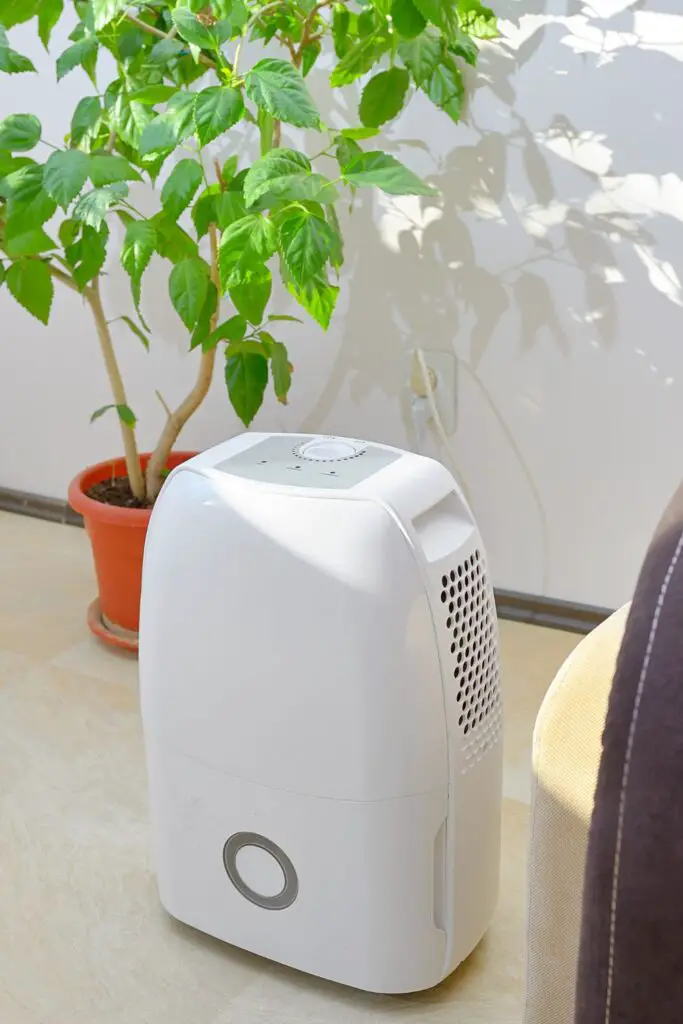
Here are 4 affordable solutions to ventilate a bathroom without windows. These mid-range solutions are best used if you are renting and prefer not to spend on permanent fixtures in the house.
6. Use a portable fan
Don’t have a budget for an exhaust fan? Try a portable fan instead.
Portable fans can help to remove excess moisture in the bathroom. Place it inside your bathroom to quickly dry wet surfaces. The fan will also help to cool the warm air and remove any odors in the room.
Keep the fan running for at least 15 minutes before turning it off. You’ll also want to keep a window open in a room nearby so the air from the bathroom can flow out.
I recommend getting a small lightweight fan that oscillates – not only will it fit any bathroom size, but it can also rotate and target different wet spots.
Difficulty Level: 😩
7. Try a dehumidifier
Using a dehumidifier is a fuss-free way of ventilating a bathroom with no windows.
A dehumidifier sucks in all the humid air from the room and blows dry air back into the area.
As a result, surfaces remain dry and the overall humidity level decreases. Both are crucial for preventing mold growth.
All you have to do is set the dehumidifier in the bathroom and turn it on once you’ve taken a shower or a bath. Make sure to leave the bathroom and shower door open and let the dehumidifier run until the air feels dry inside the bathroom.
Just remember to empty your dehumidifier for it to function optimally. You may need to do this more frequently if you live in a humid climate.
One thing to note is the size of the dehumidifier, as it should be proportionate to the size of your bathroom. A larger bathroom requires a bigger dehumidifier whereas a compact dehumidifier works for a small bathroom.
However, I recommend getting a 30-pint dehumidifier at the very least, as anything less will not be able to handle the moisture in a bathroom.
Another thing to bear in mind is that a dehumidifier needs energy to run, so it will cost more if you use it more often.
Difficulty Level: 😩 (Expensive to purchase, but easy to use)
8. Use moisture absorbers
Moisture absorbers work to reduce moisture levels in an indoor environment. There are three types of moisture absorbers: silica gel, clay absorber, and calcium chloride.
Calcium chloride moisture absorbers are the most effective, as they can absorb a ton of moisture. This makes them useful for humid spaces like a bathroom.
Moisture absorbers are inexpensive, accessible, and convenient to use. Since they come packaged in small bags, all you have to do is remove them from the packaging and hang them on your bathroom wall. Alternatively, you can insert them in drawers or cabinets in your bathroom.
Moisture absorbers typically last around 45-60 days, depending on how much moisture the bathroom has. You should discard the moisture absorber once the liquid reaches the replacement line.
Besides that, moisture absorbers like Damprid absorb foul odors and leave the room smelling clean and fresh.
Difficulty Level: 😩 (Easy to use, but needs constant replenishing!)
9. Add plants
Adding plants in your bathroom can reduce moisture and humidity in your bathroom. In addition to absorbing moisture from the air, plants also release oxygen and purify the air.
But, not all plants can survive in a bathroom with no window. Boston Ferns, Green Pothos, ZZ plants, and Aloe Vera can survive in low-light and high-humidity environments, making them great houseplants for the bathroom.
Be careful not to choose houseplants that require frequent watering. Wet or damp soil will release more moisture into the air, which will cause humidity levels to rise and prevent the bathroom from airing out properly.
Difficulty Level: 😩😫 (Plants are easy to purchase but you have to be committed to keep them alive!)
How To Ventilate A Bathroom Without Windows For Big Budgets ($$$$)
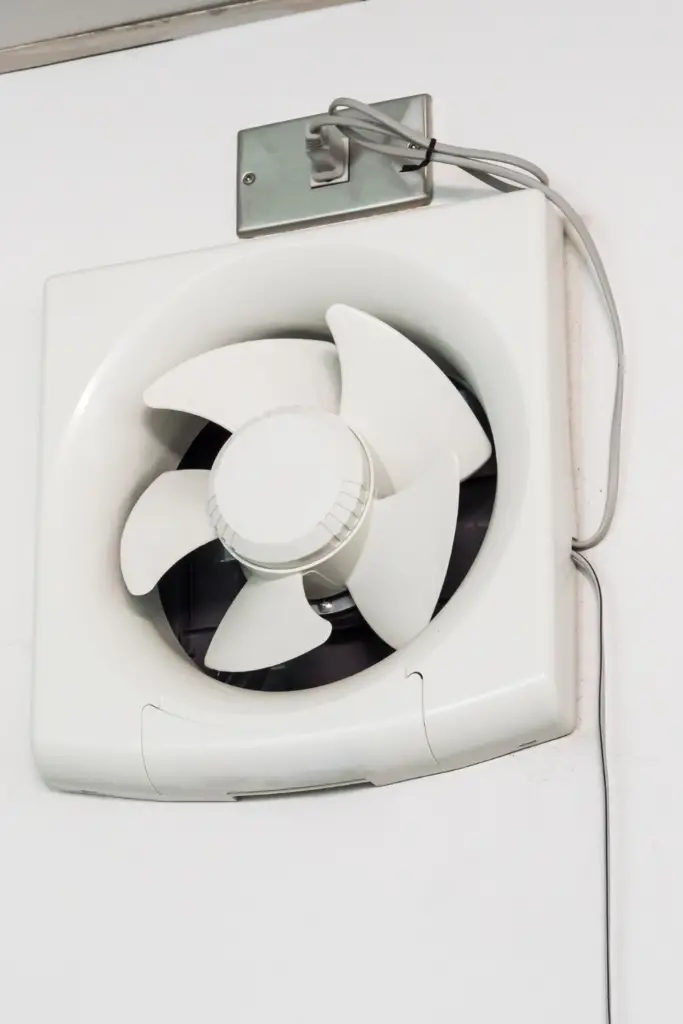
Here are 4 ways to ventilate a bathroom without windows if you have a big budget.
If you’re buying a new place or renovating, you should definitely consider one or more of the options below, as these will benefit you and your family in the long run.
10. Use an exhaust fan
Installing an exhaust fan can be pricey, but it is by far the most practical solution for ventilating windowless bathrooms.
Exhaust fans absorb all the warm air and excess moisture buildup. Plus, they also get rid of nasty odors, prevent mirror fog, and reduce rust on metal fixtures inside the bathroom.
All of the above subsequently prevents mold from growing and spreading in the long run.
If your bathroom has no windows, you’re probably going to be looking at a central exhaust fan, which channels air outdoors through pipes or ventilation shafts.
But, an exhaust fan won’t bring fresh air back into the bathroom. It’s best to keep the bathroom door open when the exhaust fan is switched on, so fresh air can flow into the bathroom.
Using the exhaust fan is easy. All you have to do is turn it on every time you take a shower or bath and let it run for 15 minutes after you’re done.
On the other hand, installing an exhaust fan is difficult. The good news is most cities require a fan if the house lacks natural ventilation. If you’re renting, you should definitely bring this up to your landlord.
The bad news? You’ll probably need to hire a professional to do the job, which can add to your cost.
But, with routine cleaning and maintenance, an exhaust fan can last up to ten years or more. It’s definitely a worthwhile investment!
Just be sure to buy an exhaust fan that’s big enough for your bathroom for it to work properly.
Not sure which exhaust fan to buy? Here’s a guide to finding the best bathroom exhaust fan for your home.
Difficulty level: 😩😫😩😩 (Challenging and costly to install, but easy to use after!)
11. Consider a fresh air intake ventilation system
An exhaust fan is great for removing moisture and humidity, but it does not bring fresh air in. It uses a one-way principle where air is transported outside, but not inside.
If you’re looking to get bad air out and fresh air in, consider installing a fresh air intake ventilation system.
Now, this is the best way to ventilate a bathroom with no windows. But, it is also the most expensive solution. Just like installing an exhaust fan, you’re going to have to hire an expert. However, it’s going to cost more than installing an exhaust fan.
The best part about a fresh air intake ventilation system is that the system will do all the work for you. You don’t have to keep your bathroom door or any windows open.
The system will automatically absorb moisture, improve air circulation, control humidity, and bring fresh air in.
This system is perfect for bathrooms furnished with delicate materials like wallpaper or wood.
Difficulty level: 😩😫😩😩 (Challenging and costly to install, but easy to use after!)
12. Change your bathroom door
If you can’t keep your bathroom door open at all times, consider changing your bathroom door to a louver door.
A louver door has horizontal slats that allow air and light to flow through. If you install a louver door for your bathroom, the open space between the shutters will help to ventilate the room even when the door is closed.
Louver doors allow warm and cool air to circulate inside a bathroom, which minimizes humidity and moisture.
Difficulty level: 😩😫 (Challenging and costly to install, but easy to use after!)
13. Install a ceiling fan
It’s not common to find a ceiling fan in a bathroom, but it can help to ventilate a bathroom with no windows.
Although a ceiling fan cannot eliminate moisture from the air like an exhaust fan, it can improve overall air circulation.
If possible, keep the bathroom door open when you’re showering even if the ceiling fan is switched on. With the bathroom door open, the ceiling fan can quickly circulate the air and reduce humidity levels in the room.
A ceiling fan requires energy to run but is generally more energy-efficient than running an exhaust fan or a dehumidifier.
Since a ceiling fan uses electricity, it’s advisable to hire an electrical engineer to install it to prevent any electrical hazards.
Difficulty level: 😩😫😩 (Challenging and costly to install, but easy to use after!)
Conclusion
Research shows that the ideal relative humidity for a home is between 40-60%.
However, the humidity level in a bathroom can increase to 80%, especially after showers or baths.
That’s why it’s important to reduce the humidity and moisture levels in the bathroom because mold can grow and spread if the humidity level is above 50%.
After reading this post, I hope you don’t have to worry anymore if your bathroom doesn’t have a window. Let me know in the comments which method you used to ventilate your windowless bathroom.

